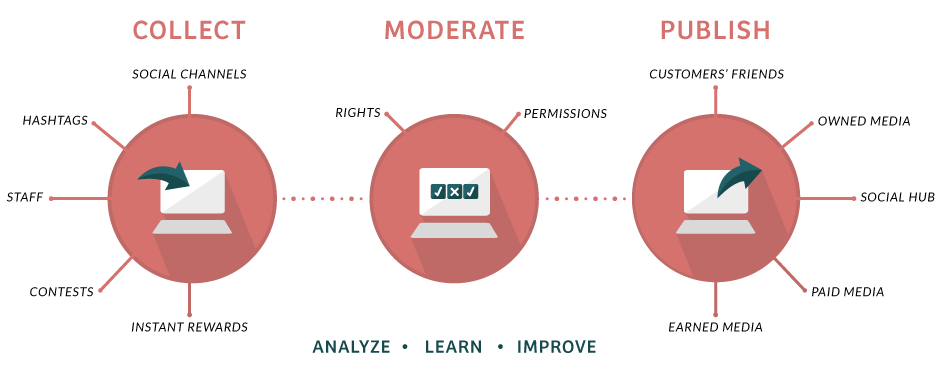
Content marketing is time consuming.
Do you often wake up in the middle of the night saying to yourself that it’s not worth the time and effort. We all do.
Writing blogs takes time, and finding or creating great images is needed, along with managing and nurturing social networks. Many people don’t stick with it because they don’t see quick results. This is where the tortoise can win against the hare by being steady and persistent. It’s a marathon and a journey, not a sprint.
One way of thinking about great content marketing is that you are building an audience before you need them. Content builds credibility, trust and followers over time. This earns you the right to then sell them something down the track.
When content marketing and social media emerged there were no tools. Today we have so many technology tools that it’s overwhelming.
But what is great with marketing tools is that you can scale your efforts. It was something I realized with Twitter early on. A few years ago I implemented one software platform that saved me 120 hours a month and it still does.
So what are some content marketing mistakes that many amateurs new to the game are making.
1. Not automating
Social media purists will tell you that automating social media to share your content is a crime worthy of naming and shaming and retribution. It is declared to not be social. I get that on a personal level but on a business level it is stupid.
Marketing in the past was a creative pursuit. The art of headline writing copy and engaging ads. Marketing is now an art and a science. The art? Copy and creative. The science? Technology and the analytics.
Social media and digital marketing is made up of many moving parts.
- Social media
- Email marketing
- Content marketing
- Blogs
- Search engine optimization
- Paid Facebook ads
- Google Adwords
- Etc
And the list goes on and on and on.
To be efficient and even survive in a digital marketing world requires tools. It now requires technology.
Social media is just a tool. It provides crowd sourced sharing of content and for business to scale its marketing it has no choice. Otherwise you will be eating every other savvy entrepreneurs dust!
I use some very effective low cost tools to automate
- Socialoomph
- Tweepi
- Twitterfeed
Want to get serious?
Then you will want to scale your efforts with crowd sourced and user generated content (UGC) technology such as Shuttlerock. This allows you to collect, moderate and publish at scale from content collected and curated from the brands advocates and fans.
What’s made this technology possible?
Smart phones with cameras, high speed wireless Internet and social networks. It sits at the center of the perfect marketing storm. The synergy of social, mobile and visual.
Automation also allows you to do social and content marketing at scale.
To add to the automation you will also need to implement marketing automation platforms like Infusionsoft, Marketo or Ontraport. These are effectively CRM platforms on steroids.
You can automate email, social campaigns and marketing funnels that provide metrics at every level.
At a simple layer you need to be measuring clicks, opt-ins and “earnings per click” (EPC)
2. Not optimizing for search engines
Content that is just optimized for search engines is like eating sawdust. Bland, dry and boring. We saw this when key word stuffing was part of the SEO experts toolkit. Google’s changes saw this practice disappear.
However, not using SEO in your content strategy means missing out on a lot of potential traffic. I made this mistake when I first started. Nowadays, before I create and publish any post on this blog, I ensure it not only grabs your attention but is also crafted to attract Google’s attention.
So find the 25-50 key phrases you want to rank for and start optimizing your website, blog and content today. Down the track you will thank me. If you get it right over 50% of your traffic will turn for free from ranking high in Google.
3. Not hustling your content
Build it and they will come is not a sensible approach.
Content marketing includes two words. There is so much great content that is just languishing behind a wall of online noise. You need to break through.
How do you do that?
One tweet is not enough. A single post on Facebook is now almost a waste of time. And one email a month is not going to cut it. Just earning attention is now a challenge. Paying for digital ads is also in the mix. A shame, but that is now the game.
Content hustling involves but not limited to:
- A multichannel strategy on social.
- Creating viral visual content
- Re-purposing text content into various media
- It requires repeat promotion.
- It means emailing that content.
- Building relationships and joint ventures with influencers and other bloggers.
- Guest posting
If you thought content marketing was a get rich quick scheme then maybe its time to give up before you start.
4. Not working on your headlines
List headlines are everywhere.
You know what I mean. They look like this:
- 23 Ways to clean your teeth
- 7 simple tips to keeping fit in only 5 minutes a day
The lists go on and on and on. Most of us are so over them but they still keep coming.
A recent study by Fractl and Buzzfeed over 6 months and 220,000 articles, looked at 5 different types of content and guess which of the five types worked best? Listicles.
Buzzfeed is the master of them. Here is an example titled “”27 Completely Innocent Images That Will Bother You For Some Reason”
So why?
They work! If they didn’t then these top media sites and blogs would stop using them but the metrics tell you the truth.
But that Buzzfeed article also reveals something else.
The power of using strong visuals that almost beg to be shared. If you take a closer look at the technology on Buzzfeed, each image has sharing buttons. So you can not only share the post but share each image.
5. Not experimenting
Coca Cola rewrote their marketing strategy and content was at its core. They also created a ratio that highlighted the need for on-going experimentation. Here is the ratio explained.
Part of the Coca Cola content strategy is applying a 70/20/10 Investment principle to creating “Liquid content“.
- 70% of your content should be low risk. It pays the rent and is your bread and butter marketing (should be easy to do and only consumes 50% of your time)
- 20% of your content creation should innovate off what works.
- 10% of your content marketing is high risk ideas that will be tomorrows 70% or 20%…. be prepared to fail
This provides a blueprint regarding moving on from just developing white papers, to trying some content that is more visual, courageous and engaging in web world that has embraced multimedia and interactive content.
6. Poor quality content
Forget writing for search engines.
Now I know told you before that you needed to optimize for search. But if that is all you do and your content is designed only for search then it will turn people away.
Content that is fun, conversational and creative will touch people’s hearts and they will come back.
How would you define great quality content? Here are some simple tips:
- Create or find fun visuals that are creative and shareable.
- Write introductions that engage your audience within seconds.
- Simplicity. Posts and articles should be written in a manner that almost everyone can understand.
- Good grammar and spelling. Now I didn’t say perfect.
- Surprise people with an insight that they may not have heard of. It could be a fact or statistic that is revealing
- Conversational. Language is always evolving and people now like to read articles that are written like we speak.
- Solves problems, inspires, entertains
7. Not building and owning your online content distribution
In the past you bought access to your customers by placing ads in newspapers, magazines and even using a direct mail company. In a digital age and on a social web you need to invest in growing your own tribe and network.
It is an unprecedented opportunity that didn’t exist before. It is the digital marketing trinity.
- Email list
- Social networks on Twitter, Facebook and LinkedIn
- Search engines
This is the work of years and persistent effort.
The other task is to own your traffic. What do I mean?
There are 3 ways to create web traffic. Pay for it, earn it or own it.
1. Paid traffic
If you have the money and the budget then paying for traffic is fine.
- Facebook Ads
- PPC (Pay per click) such as Google Adwords
- Banner ads
- Retargeting
2. Earned traffic
This takes time to earn and is a journey of years.
- Organic search engine traffic that comes from ranking high in a Google search
- Traffic from your social media followers and networks
- Referral traffic from people linking to your website and blog
Your primary goal should be to “convert paid and earned traffic” that arrives at your website and “convert it into owned traffic“.
That is “your” email list.
This can be done by converting traffic through a call to action such as a webinar, ebook or premium content that requires registering or subscribing via an email.
With your email list you can reach your customers “when you want” to and not at the mercy of Google or Facebook algorithms!
Neglect this strategy at your peril.
It doesn’t matter whether you are a small blogger or a big brand. The money is still in your email list.
8. Not thinking like a publisher
All of us need to think like publishers. Google hates silence. A website and a blog that isn’t updating content on a regular basis will not be crawled by Google’s search engine spider.
You will not earn authority on search engines. People will not follow you on social networks if your content is poor, not persistent.
So how does a publisher think and act?
Here are some of the types of actions and tactics that all publishers do.
- Consistent publishing
- Creative content
- Listen to their readers
- Market their content
- Test their content
9. Not learning from the innovators
If you are only watching your niche for ideas then you are going to miss out on a lot of insights, tactics and tips that could lead you to become a leader in your industry.
Some of the top content publishers in the big brand area that are worth keeping an eye on are Red Bull and Lego. In the online publishing sector Upworthy, Buzzfeed and Viral Nova are innovative and very successful.
In the blogging space Hubspot, Buffer and Kissmetrics all do great work.
Case study in innovation outside their niche
A great example of a blog that innovated and modeled its content creation and marketing is Movoto a real estate services company. It looked at what Upworthy were doing and used that as a model even though it was outside their niche.
They are a real estate services company that has taken some these ideas and woven it into their content creation, marketing and link hustling. They have taken their real estate blog from 2,000 to 18 million views per month in just 2 years!
10. Not paying attention to conversion and analytics
All marketers have problems to solve and overcome. But there are two key challenges when you boil it down.
- Traffic problem
- Conversion problem
Social media and content marketers are sometimes obsessed with traffic and social shares and miss out on what is really important. Converting that attention and traffic into leads and customers.
This means you need to move from the nice headline metrics to some real hard core numbers. These include Clicks, opt-ins and earnings per click (EPC).
Maybe it’s time to start looking closer at the metrics that matter and start optimizing that traffic into paying customers?



